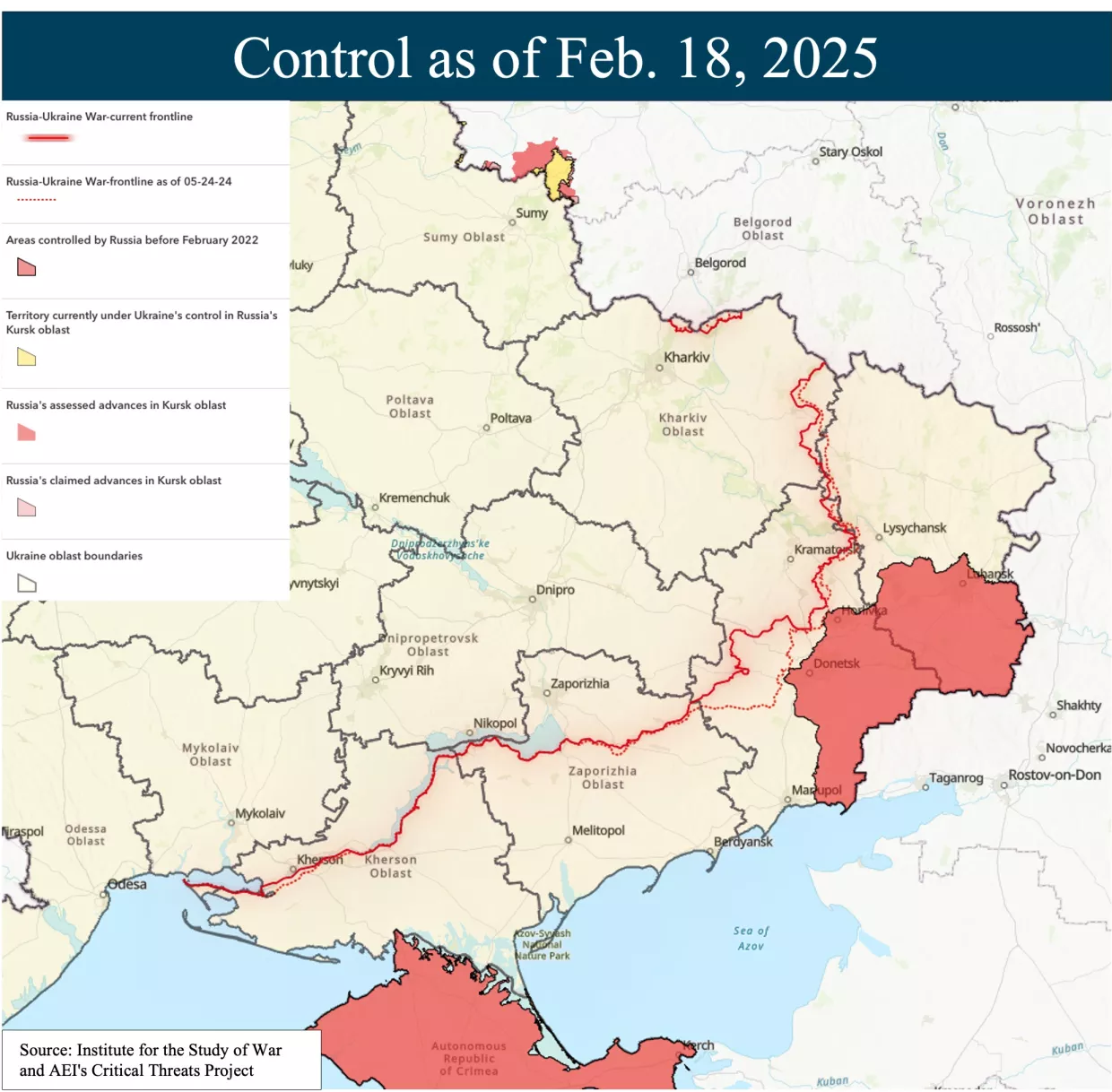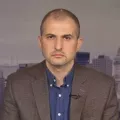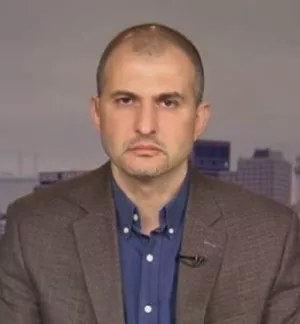Introduction
Is Vladimir Putin a rational actor who weighs costs and benefits before making a momentous decision, such as whether to invade another country? Multiple scholars of Putin and his country think he is. If so, the third anniversary of his decision to order a full-scale invasion of Ukraine provides an appropriate opportunity to take stock of the costs and benefits of that invasion for Russia’s dictator and the country he rules. Before we do so, however, we must note that providing quantitative estimates of these costs and benefits is, predictably, very challenging, as it is difficult to find rigorous research that separates the impacts of the aggression on aspects such as, for instance, Russia’s economic output, from other factors that impact its GDP.1 It is also difficult to estimate the duration of these costs, given Russian authorities’ efforts to reduce them through measures such as the evasion of sanctions. While trying to estimate the “pros” and “cons” of Russia’s invasion for Russia, we, of course, acknowledge the horrendous costs which have been endured by Ukraine and Ukrainians, including hundreds of thousands in military casualties and thousands of civilian fatalities.2
Costs
Humanitarian impact: displacement, civilian deaths, veteran crime:
- Civilian losses: at least 388 individuals killed inside Russia as of December 2024.
- Internal displacement: At least 120,000 fled from Russia’s Kursk region alone (estimate in October 2024) with 3,000 staying to live in the Ukrainian-controlled parts of this region (estimate in February 2025). This internal population displacement and criticism of the authorities’ handling of these individuals’ plight creates additional social and political pressure on Putin’s regime.
- External displacement: 800,000 emigrated for economic or political reasons, 0.6% of Russian population.
- Violent crimes by veterans, including offenses committed by convicts who were released from jail on the condition that they would join combat on the Russian side for 6 months or more: at least 1,500 fell victims of these crimes at hands of veterans with 242 persons killed and 227 suffering grave bodily injures (estimate in September 2024).
Military personnel losses: Estimates of the number of Russian servicemen killed or wounded or missing vary, but most recent estimates show casualties of 700,000 or more, for a daily rate of 670 casualties, which is 50% less than the lower estimate of the casualties suffered by the PLA during the Sino-Vietnamese War of 1979, a comparable conflict.
- U.S. DoD: 600,000+ killed or injured (estimate in October 2024).
- IISS: 783,000, including 172,000 killed and 611,000 injured (estimate in late 2024).
- NYT: 700,000+ killed or injured (estimate in January 2025).
- Republic.ru: 1,200,000, including 300,000 killed and 900,000 wounded (estimate in February 2025).
- Donald Trump: 1,000,000 killed (estimate in January 2025).
- RF MoD: 48,000 missing (estimate in December 2024).3
Military equipment losses:
- Vehicles and equipment: 20,382 (estimate in February 2025).
- Tanks and armored vehicles: 11,819 (estimate in February 2025).
- Aircraft: 305.
Economic costs generated by Western sanctions: Russia remains the most heavily sanctioned country in the world in 2025. Over 20,000 sanctions have been levied by 50 countries, more than 80% of which were implemented following the February 2022 full-scale invasion of Ukraine, according to Forbes.
The punitive measures against Russia are estimated to have caused the following outcomes:
- An estimated $340 billion of Russian Central Bank reserves have been frozen.
- Russia’s financial sector suffered hundreds of billions of dollars in “direct losses” from sanctions, according to an internal Russian Finance Ministry document obtained in the fall of 2024 by Bloomberg.
- Russia’s energy sector lost an estimated $78.5 billion in exports earnings compared to a no-sanctions scenario from December 2022 to June 2024, according to the Kyiv School of Economics.
- A journalistic investigation estimated in March 2024 that Ukrainian strikes had rendered facilities which accounted for 1/6th of the production of gasoline and diesel fuels in Russia non-operational.
- As of Jan. 1, 2025, a total of 467 companies have completely exited Russia, according to the Kyiv School of Economics.
The punitive measures are likely to have contributed to the following outcomes:
- Russia’s GDP declined by some 2.3% in 2022 before growing by 3.6% in 2023.4 The IMF estimates that the Russian economy then grew by 3.8% in 2024, but this growth is expected to slow. The IMF’s latest World Economic Outlook foresees Russia’s economic growth slowing down to 1.4% in 2025 and 1.2% in 2026. We could not find any rigorously researched estimates of how much Russian GDP would have grown in a no-sanctions scenario.
The punitive measures are likely to have contributed to the emergence of the following financial costs:
- The sanctions are also likely to have contributed to emergence of a hole in Russia’s federal budget, with a deficit equivalent to 2.3% of GDP in 2022; in contrast, prior to the invasion, the Russian government had forecast a budget surplus of 1% for 2022. In 2023, the budget deficit hit 1.9% of GDP, according to the Russian finance ministry. And in 2024, the deficit of Russia’s federal budget was estimated at 1.7% of GDP, even though Russian authorities initially projected a deficit of only 0.9% of GDP in that year.
- As of Feb. 18, 2025, the Russian ruble was worth 0.01093 U.S. dollars, which represents an 8% decrease since Russia’s invasion of Ukraine.
- In 2022, Russia saw a notable spike in its inflation rate, which reached 13.75%. In 2023, it decreased to 5.86%, but then rose again in 2024, reaching 9.5%.
- As of late 2024, the Central Bank’s key interest rate was at a record-high 21%, making survival much harder for many civilian businesses in the country. In fact, the number of corporate bankruptcies in Russia increased by 26% in the first three quarters of 2024 compared to the same period of 2023, totaling 6,392, according to Interfax.
The punitive measures are likely to have contributed to the emergence of the following technological costs:
- As of October 2022, Russian semiconductor imports dropped 70% since the country became subject to broad Western sanctions and export controls after the invasion in February 2022. However, China subsequently helped to compensate for this decline.
- As of 2023, Russia planned to produce 1,000 passenger aircraft of all types by 2030, including 94 in 2023-2024. In reality, only 14 airliners were produced in those two years. The sanctions have also led to the seizure of 76 Russian airliners.
- Partially due to punitive reductions in exports of parts to Russia for car manufacturing, car production in Russia declined in 2022 by 60% compared to 2021, to 650,000. However, in 2023 already that production rebounded by 16% to 720,000. Car production kept growing in 2024, posting a growth of 33% with 1 million cars produced that year.
Expansion of what Russia sees as a hostile bloc to additional stretches of Russia’s land borders and territorial borders: Putin’s invasion of Ukraine has also created geopolitical costs for Russia that he could not possibly welcome. Not only has the war prompted existing NATO members to commit to an expansion of their military capabilities, but it has also prompted long-neutral Finland and Sweden to gain membership in the alliance. Sweden’s and Finland's inclusion in NATO brought all of Russia’s Baltic Sea neighbors into the alliance and expanded the land border Russia shares with NATO members by 833 miles (1,340 kilometers). That expansion means only 488 miles (786 kilometers) separate southeastern Finland and Moscow as the crow flies. This cannot be good news for the country, whose leader stressed that one reason Russia cannot accept NATO’s expansion to Ukraine is that the time it would take for a NATO missile to fly from Kharkiv to Moscow, which are separated by the distance of 396 miles (638 kilometers) is 7 minutes (at this speed, it would take the same missile 8 1/2 minutes to fly the 488 miles that separate Finland and Moscow.)
Geopolitical costs: The Russian leadership’s inability and or/reluctance to divert resources from the war against Ukraine to help official allies has led to a dramatic decline in Russia’s influence over Armenia and Syria. The failure to come to the rescue of these allies could not help impacting the cost-benefit analysis by leaders of countries that are weighing whether to continue allied relations with Russia or to enter such relations.
Diplomatic semi-isolation: Russia faced significant isolation from Western countries, which have imposed sanctions targeting its economy and political elite, in 2022-2024. However, Russia has sought to strengthen ties with non-Western nations aiming to mitigate the impact of Western isolation. A sample of votes in 2022 on the Russian-Ukrainian war-related resolutions in the U.N. General Assembly (UNGA) shows that Russia has avoided full isolation, even though its reputation did suffer from its aggression against a sovereign state. About one-third of countries that voted on the following UNGA resolutions on the Russian-Ukrainian war failed to condemn Russian aggression:
- 03.02.2022-UNGA Resolution ES-11/1: “Aggression Against Ukraine”
- 141 yes; 5 no; 35 abstentions.
- 03.24.2022-UNGA Resolution ES-11/2: “Humanitarian consequences of the aggression against Ukraine”
- 140 yes; 5 no; 38 abstentions.
- 10.12.2022-UNGA Resolution ES-11/4: “Territorial integrity of Ukraine: defending the principles of the Charter of the United Nations”
- 143 yes; 5 no; 35 abstentions.
More recently, Trump’s decision to reverse his predecessor’s isolation strategy vis-à-vis Russia indicates that even Russia’s semi-isolation may soon be over. In fact, Feb. 24, 2025, saw the U.S. join Russia and 16 other nations to vote against a UNGA resolution condemning Russia’s invasion of Ukraine. The resolution passed with 93 votes in favor. China abstained, alongside 64 other countries, according to FT’s count.
Russia’s reputation as a world-class military power has been damaged: In advance of its second assault on Ukraine in 2022, Russia spent months in preparation for a rapid multi-pronged offensive launched not only from its positions in Crimea and the Donbas, but also from the territory of its ally Belarus. Less than two months following the Feb. 24, 2022, invasion, however, the Russian forces found themselves in retreat.
While we have no way of knowing for sure, it is unlikely that Putin and his generals expected such a setback. If they had, they would not have told members of the invading formations to pack their dress uniforms. That even some prime Western experts on the Russian military—who are arguably less susceptible to Potemkin narratives plied by some of Russia’s less scrupulous commanders—overestimated the capabilities of Russia’s war machine reaffirms the likelihood that Putin himself suffered from excessive optimism. They were not alone. Two days before the invasion, then U.S. Chairman of the Joint Chiefs of Staff Gen. Mark Milley gave visiting then Ukrainian Foreign Minister Dmytro Kuleba a “you’re going to die” speech. “They’re going to roll into Kyiv in a few days,” Milley told Kuleba, according to The New York Times.
Territorial loss: On Aug. 6, 2024, Ukraine undertook a surprise invasion of Russia’s Kursk region, soon capturing 470 square miles of Russia, including the city of Sudzha. Ukraine still controls 172 square miles of its original salient in Kursk.
Benefits
Territorial gains: Russia has gained significant territory in Ukraine since its second invasion. In fact, Russia’s second invasion added 12% of Ukraine’s territory to the 7% Russia controlled prior to the Feb. 24, 2022, full-blown invasion (that includes Crimea).
- As of late February 2024, the total square miles of Ukrainian territory under Russian control amounts to 43,714 square miles (roughly the equivalent of the U.S. state of Ohio).

Seizing Ukraine’s natural and industrial resources: Russia’s aforementioned territorial gains have enabled it to seize more of Ukraine’s natural resources. Ukraine has large underground deposits of critical minerals, including lithium, graphite, cobalt, titanium and rare earths such as gallium, which are essential for an array of industries from defense to electric vehicles, according to estimates cited by respected British economist Adam Tooze.5 As Robert Mugga and Rafal Rohozinski write: “The geographic focus of Russia’s occupation efforts is hardly coincidental. Indeed, Ukraine’s Dnieper-Donetsk region alone accounts for 80% of known conventional oil, gas and coal production and reserves. Most identified critical minerals, especially Ukraine’s 22 rare-metal formations, are concentrated in Donetsk, Dobra and Kruta Balka.”
- Coal: Russian forces control more than 80% of Donbas, which is believed to account for 90% of Ukraine’s coal reserves, and are now within the city of Pokrovsk, which is home to Ukraine’s last remaining coking coal mine.
- Metals: About 40% of Ukraine's metal resources are now under Russian occupation, according to estimates by Ukrainian think-tanks, cited by Reuters.
- Rare earths: Ukraine’s deposits of 21 rare earth elements from the list of 30 substances the European Union defines as “critical raw materials,” accounted for approximately 5% of the world’s reserves, according to the U.N.
- We have been unable to find estimates of how much of these deposits Russia may have seized, but we found one claim that Russian forces are closing in on the Donetsk region’s Shevchenko, which is home to one of the biggest lithium deposits in Ukraine.
- Agricultural Land: Southern Ukraine is known as the "breadbasket of Europe.” Russia controls most of the territory of two of Ukraine’s southern regions, Zaporozhia and Kherson.
- Industrial facilities: Donbas, >80% of which Russia now controls, once accounted for a quarter of Ukraine’s industrial production.
- Control over these resources provides strategic economic benefits to Russia and significantly impacts Ukraine's economy and export capabilities. Transfer of the control of these assets to members of the Russian elite strengthens their support for Putin and his war.
Adding population through conquest: The population of the Ukrainian territories under Russian control (including Crimea, and parts of Donetsk, Luhansk, Zaporizhzhia and Kherson regions) was estimated to total 5-7 million as of 2024. If accurate, this represent a 3.4%-4.8% increase to Russia’s 146 million (this number excludes the population of territories annexed by Russia in 2022). Ukrainians in Russian-occupied Ukraine and those whom Putin has illegally deported to Russia amount to roughly 7% of Russia’s pre-war population, according to ISW.
- According to official Ukrainian sources from January 2022, the overall population of the areas now occupied by Russia was 6.4 million people, Nikolay Petrov writes for SWP, estimating that the current population of these areas is around 3.47 million people.
Reducing the probability of Ukraine’s NATO membership and preserving the buffer against this alliance: The outcome of the February 2014 color revolution in Ukraine led to a significant increase in the Ukrainian government’s efforts to obtain membership in NATO for this country. However, Russia’s demonstration of its preparedness to use force to foil Kyiv’s plans, which Putin believes to be running counter to Russia’s vital interests, by invading Ukraine in 2022 seemed to have convinced some members of the alliance, which operates by consensus, to refrain from supporting these plans. As of October 2024, governments of at least seven countries reportedly opposed Ukraine’s membership and at least one more country has joined them since then (Trump’s administration). Speaking this February, U.S. Secretary of Defense Pete Hegseth represented the U.S. position on NATO membership for Ukraine as unrealistic. “The United States does not believe that NATO membership for Ukraine is a realistic outcome of a negotiated settlement,” Hegseth said.
Gaining military experience in somewhat modern warfare: While Russia’s aforementioned claim to be a world-class military power has been dented, Russian armed forces did gain some valuable experience in modern warfare, and the war has in fact been a testing ground for new military technologies—in particular drones. Older technologies—including especially heavy tanks such as models T-72, T-80 and T-90 main battle tanks—have not fared well, and this experience has proven valuable as well, causing Russia to innovate new tactics to gain ground in its attrition campaign in eastern Ukraine. Russians have also proven adept at the use of sophisticated jamming technologies to blunt the impact of Ukraine’s greater reliance on aerial, land and seaborne drones for surveillance and attack, as well as to develop a range of its own drones.
The war with Ukraine has strengthened Russia's mutually beneficial cooperation with nations opposing the West, including China, Iran and North Korea, as well as other countries and non-state actors that maintain either highly competitive or actually adversarial relations with the U.S. and some of its allies. In conducting the aggression against America’s wishes, Russia has also demonstrated its status as a great power capable of resisting the influence of the world's strongest state and its allies. Despite facing economic, military and geopolitical pressure from Ukraine's Western supporters, primarily (until recently) led by the U.S., Russia has shown its ability to stand firm against what has been the most powerful alliance globally.
Robust support for Putin’s rule: The resumption of economic growth in Russia in 2023, coupled with labor shortages, helped to fuel a recent increase in real incomes (more than 8.5% in 2024), which, in its turn, made common Russians less likely to revolt against Putin’s rule. In fact, the common Russians’ approval of Putin has hovered above 80% since November 2022.6 The Russian leader could also count on at least some of the countries’ business elites’ loyalty, as Russia’s rich got richer and more numerous in 2024, despite sanctions. The total wealth of the richest Russian businessmen has grown by $31 billion since the beginning of 2024, to $360 billion, according to the Bloomberg Billionaires Index rating. The same year saw 19 new Russian dollar billionaires join Forbes’s ranking, which is the highest number of new dollar billionaires Russia has produced since 2011, according to Re: Russia.
Rise in domestic nationalism: The war has also bolstered nationalistic sentiments in Russia, from which Putin and the ruling establishment as a whole benefit. Putin’s approval soared in the run-up to the invasion and, as stated above, has hovered above 80% since November 2022. In addition to support for the commander-in-chief at 87% as of January 2025, support for the Russian military’s actions remains high at 78%, that month, according to Levada.
Concluding remarks
Having stated the costs and benefits, we, nevertheless, cannot calculate some net value that would tell us what a rational leader should conclude about whether or not the aggression has “paid off” and what it means for the leader’s next steps.
More importantly, we do not know what value Putin assigns to each of these costs and benefits. For instance, for many, including the authors of this blog post, the horrendous casualties suffered by the Russian armed forces as they failed in what Putin mistakenly believed (on the counsel of his advisers) would be a blitzkrieg, should have made any reasonable leader—who puts the interest of his subjects first—stop. But, as reality shows, Putin—whose insensitivity to Russian casualties was noted by one of us as early as 2015—does not seem to find such costs prohibitive, so long as the Russian public is not aware of the true scale of these casualties as they are duped by Kremlin propaganda into believing Russia is somehow fighting a just war.
Thus, rather than assume that Putin would choose a policy option that, to paraphrase Donald Trump, “common sense” would indicate, one should, as one of us has earlier suggested in an analysis of Putin's decision-making with regard to the war against Ukraine, try to grasp what costs and benefits the dictator associates with each policy option available to him and, more importantly, what value he assigns to each of the pros and cons, no matter how misinformed his perceptions might be.
Footnotes:
- In addition to conducting searches in already published studies of the war, we have also turned to the Kyiv School of Economics, which tracks many of the war costs, as well as to renowned Russian economist Sergei Guriev for estimates of the total cost of sanctions. Guriev was unaware of reliable estimates of such costs, while KSE has yet to respond to our inquiry.
- For more of our recent estimates of Ukraine’s costs, please see RM’s The Russia-Ukraine War Report Card, Feb. 19, 2025
- The losses contributed to Russia’s natural population decline, excluding territories annexed after 2022, which increased by 20.4% in 2024 compared to 2023 (596,200 people versus 495,200). This is stated in the Rosstat report on natural population movement. Natural decline is understood as the excess of deaths over births. In 2024, 3.4% fewer children were born in the country, and 3.3% more people died. Rosstat currently counts 146.028 million people in the country. According to Rosstat's forecast, by 2030, Russia's population could shrink by another 3 million people, to about 143 million, as reported by Istories.
- Even if Russia added the full Gross Regional Product of the entire Ukrainian regions of Donetsk, Luhansk, Kherson and Zaporizhzhia, which its forces control only partially, that would fail to compensate for the more than 2% decline of its GDP in 2022.
- Ukraine has large underground deposits worth up to $11.5 trillion of critical minerals, including lithium, graphite, cobalt, titanium and rare earths such as gallium, that are essential for an array of industries from defense to electric vehicles, according to British economist Adam Tooze. Various reports have claimed that Ukraine has mineral deposits worth upwards of $10 trillion. (Bloomberg, 02.18.25, RM, 02.21.25) $10–$11 trillion seems to be high, given that the total value of all mineral reserves in Russia was estimated to be about $1.44 trillion whereas the 2017 estimate was about $910 billion, according to a Feb. 2023 report by the U.S. Geological Survey. Also for context: the entire global trade in 2024 was 33 trillion USD.
- Polls in Russia, even those conducted by a leading independent pollster like the Levada Center, can only partially reflect the real views of the Russian public. That Russians are increasingly reluctant to speak their mind even in anonymous polls should come as no surprise, given increasingly harsh laws restricting freedom of speech and punishing dissent.
Simon Saradzhyan is the founding director of Russia Matters. Ivan Arreguín-Toft is the editor of Russia Matters. Angelina Flood is the managing editor for Russia Matters.
This is an evolving draft that may be updated.
Opinions expressed herein are solely those of the authors. Photo by Mikhail Metzel, Sputnik, Kremlin Pool Photo via AP.
*This post was corrected on Feb. 28, 2025, to provide the source of the "common sense" quote in the final paragraph.
Saradzhyan, Simon, Ivan Arreguin-Toft and Angelina Flood. “3 Years Later: What Russia’s Aggression in Ukraine Has Cost It and What It’s Gained.” Russia Matters, February 24, 2025
The full text of this publication is available via Russia Matters.








